Exploring Landsurf: The Next Wave in Surf Culture
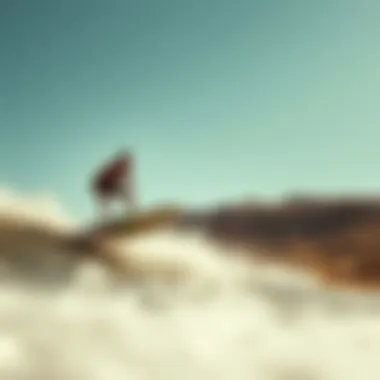
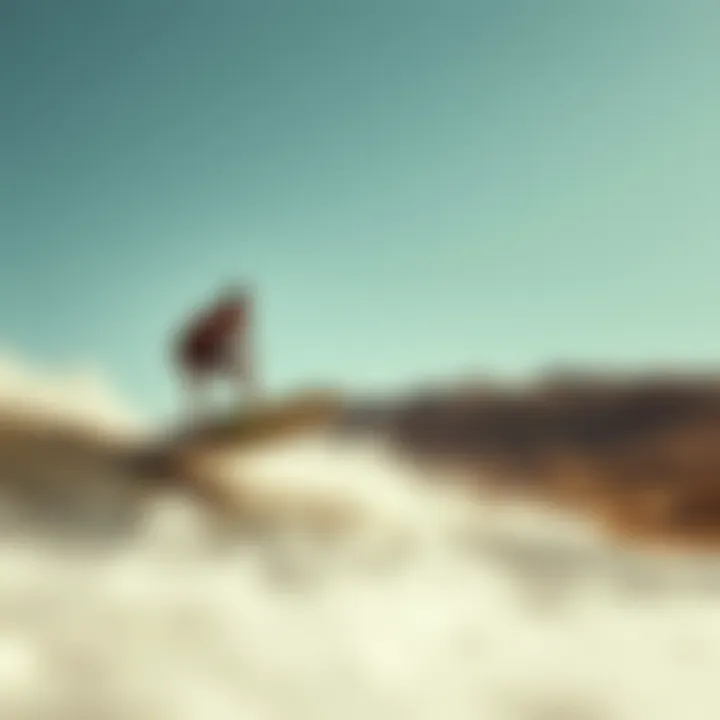
Intro
Landsurfing, a captivating evolution of the traditional surfing experience, has begun to carve out its own niche in the vast world of surf culture. This exciting variant thrives on a mixture of creativity and physical challenge, attracting a diverse community eager to push the boundaries of their outdoor pursuits. Unlike ocean surfing, landsurfing happens on land, utilizing specially designed boards that allow riders to navigate various terrains, from sandy beaches to dusty trails. The emergence of this sport not only showcases innovative techniques but fosters a sense of community that echoes the camaraderie found among ocean surfers.
In this article, we will dive into the essential components of landsurfing: the mastery of techniques, the intricacies of equipment, and insights from those living the landsurf lifestyle. By examining various landscapes and sharing personal narratives, we aim to expand understanding about how landsurfing acts as an extension of traditional surfing culture. Prepare to learn about the gear needed, the skills acquired, and how this thrilling adeptness shapes both the experience of adventure seekers and the broader surfing community.
Defining Landsurf
In the realm of outdoor sports, landsurfing emerges as a compelling variation of traditional surfing. Defining landsurfing goes beyond just naming a new sport; it encapsulates a fresh evolution of surfing culture that invites enthusiasts to explore different terrains while employing adapted techniques and equipment. This activity harmonizes the thrill of surfing with the accessibility of land, thereby broadening the horizons for surfers and adventurers alike. It's more than riding — it’s about embracing a lifestyle that connects individuals with nature, challenges their skills, and fosters community.
Historical Context
Landsurfing is rooted in a rich history that traces back to the classic surf culture of the 20th century. While surfing originated in the ocean, characterized by its fluid movements and responsive equipment, the desire to bring those sensations ashore led to the conceptualization of landsurfing. The inception can be linked to the burgeoning skateboarding scene of the 1970s, where surfers adapted their skills to wheels instead of waves. Tools such as longboards and specially designed trucks allowed for a form of skating that mimicked the flow and maneuverability of surfing.
Through the years, as skate parks evolved into more sophisticated venues, enthusiasts began to crave surfaces that reflected the thrill of surfing the ocean. The early 2000s saw a revival of landsurfing as innovators began designing specific gear like landsurfboards, harnessing the same principles that made surfing an art form but translating it to streets, hills, and parks. Hence, understanding landsurfing’s history provides a foundation for its acceptance and growth in modern sports culture.
Core Principles of Landsurfing
At its essence, landsurfing stands on several core principles that guide practitioners in their pursuit of thrills and skills. These principles not only define the activity but also highlight its unique advantages:
- Balance and Posture: Much like traditional surfing, landsurfing demands an acute sense of balance and body awareness. Riders must learn to position their weight thoughtfully to maintain stability while maneuvering on varied terrains.
- Flow and Movement: Landsurfing emphasizes the importance of smooth transitions and flowing movements. Riders seek to replicate the glide of surfing by shifting weight seamlessly from one board side to another, promoting an almost meditative rhythm.
- Adaptability: Each landscape presents its own set of challenges, from the roughness of a gravel path to the smoothness of pavement. Landsurfers need to adapt their techniques and board designs to harness the benefits and mitigate the drawbacks of their chosen terrain.
- Community Engagement: Much like the surfing community, landsurfing fosters a strong sense of camaraderie. Performing together, exchanging tips, and participating in events or gatherings are vital for personal growth and collective progression.
By grasping these principles, one not only learns to ride but also develops a deeper connection with landsurfing as a lifestyle, fine-tuning skills that can transcend beyond merely riding a board.
"Landsurfing isn’t just about the ride; it’s about the community and connection with nature."
The Evolution of Surfing Culture
Surfing has always been more than just riding waves; it encapsulates a lifestyle, an identity, and a connection to nature that stretches back centuries. As it transitions beyond the confines of ocean water to landsurfing, we witness an evolution steeped in rich narratives and cultural shifts. The importance of this evolution in the context of landsurfing cannot be overstated. It underscores the adaptive nature of surfing, which mirrors our own evolution as outdoor enthusiasts and adventurers.
From Ocean to Land
Landsurfing's birth is rooted in the traditional surfing community's desire to find new avenues for expression and thrill when the waves were unkind. This migration from ocean surf to land surf speaks volumes about the human spirit's insatiable appetite for adventure. The basic premise remains the same: balance, agility, and finesse. Yet, the elements of the sport change significantly when grounded on terrestrial surfaces.
The transition from ocean waves to grassy hills and smooth pavement necessitates not only different techniques but also a reimagining of equipment. Using specially designed landsurfboards—often wider with a lower profile to accommodate varied terrains—riders can now venture off the beaten path. Different environments bring various challenges. For instance, navigating through gravel or dirt requires a distinct skill set compared to carving through ocean waves.
Here are some ways in which the evolution from ocean to land manifests:
- Adoption of Alternate Techniques: Traditional techniques utilized in surfing are adapted. For instance, rather than paddling out to catch a wave, a landsurfer gains speed through a kicking action or pushing with their feet.
- Equipment Innovation: Landsurfboards, often featuring wheels and rubber-footed grips, tame the diverse surfaces encountered. Riders can customize their setups depending on whether they're on concrete, dirt paths, or even sand dunes.
- An Expanded Community: This evolution has invited a wider audience. People of all ages can find joy in landsurfing—whether they’ve experienced the ocean waves or are new to board sports altogether. The sport is thus inclusive, fostering a sense of camaraderie among enthusiasts.
Cultural Significance
The land-surfing movement isn’t merely about the thrill; it is a profound cultural shift. It embodies the essence of adaptation and resilience, echoing broader human experiences. As landsurfing integrates into the global culture, various elements come into play, enhancing its significance:
- Breaking Geographic Barriers: Unlike its ocean counterpart, landsurfing is available to those who live far from coastlines. It allows individuals to engage in the surfing culture without needing to hop on a plane to the nearest beach, ultimately enriching local outdoor culture, regardless of geographical location.
- Community Building: Landsurfing has catalyzed the growth of vibrant communities both online and offline. Social media platforms like Instagram and Facebook are bustling with enthusiasts sharing tips and highlighting their favorite terrains. Not only does this community engage current landsurfers, but it also attracts newcomers eager to learn.
- Cultural Exchange: With landsurfing thriving across different regions, each culture adds its own flair, creating rich tapestries of styles and techniques. Riders from various backgrounds come together, contributing their unique experiences and enhancing the sport’s cultural fabric.
"Landsurfing is not just a sport; it's a community—a way of life for those who seek adventure on their terms."
As landsurfing continues to grow, the cultural implications will ripple across various strata of society. It invites fresh discussions about lifestyle choices, community values, and the great outdoors' role in our lives.
Landsurfing Equipment
Understanding landsurfing equipment is crucial for anyone interested in this exciting sport. The right gear not only enhances performance but also ensures safety and comfort. For those transitioning from traditional surfing, the equipment choices in landsurfing present unique challenges and benefits that can reshape the entire riding experience.
Landsurfboards: Design and Function
The core of landsurfing is undoubtedly the landsurfboard itself. Unlike standard surfboards that glide over water, landsurfboards are engineered specifically for land-based surfaces. The design varies considerably, adapting to various terrains, such as asphalt, dirt, or even grass.
- Material Considerations: Most landsurfboards are constructed using lightweight materials like fiberglass or special polymers. This reduction in weight allows for greater maneuverability. Plus, some boards feature a flexible deck to absorb shock and enhance comfort, crucial for long rides.
- Wheel Configuration: The wheels are where innovation shines. Landsurfboards typically utilize larger, wider wheels to accommodate rougher terrains. Their hardness also affects the type of traction one gets. Softer wheels, while absorbing shocks well, can slow a rider down on hard surfaces. Conversely, harder wheels provide speed but may not offer the same comfort level on bumps or cracks.
- Stability Features: A lower center of gravity is vital in landsurfboard design. Some boards have integrated foot straps that help in maintaining stability and control, especially during tricks. Moreover, an increase in engagement with the board leads to better balance and confidence, making it easier for beginners to learn and for experts to execute complex moves.
In essence, selecting the right landsurfboard hinges on understanding one’s preferred riding style, environment, and personal comfort.
Protective Gear Insights
When it comes to riding adrenaline-fueled waves on land, safety should never take a back seat. Protective gear is not just an accessory; it’s an essential part of any landsurfer's equipment arsenal. The unexpected tumbles and spills are part of the game, and the right gear can mean the difference between a minor bruise and a serious injury.
- Helmets: A good helmet is non-negotiable. Look for options with adequate padding and an adjustable fit. Modern designs often include ventilation, which is critical for comfort during extended rides.
- Knee and Elbow Pads: These should be a must-have for any land surfer. The falls can be tough on joints, particularly the knees. Select pads that are both cushioned and breathable to avoid overheating during hot conditions.
- Wrist Guards: Especially for beginners, wrist guards are critical since they help prevent injuries during falls—wrist fractures can be quite common in landsurfing.
- Footwear: Some riders prefer barefoot riding for the tactile feel. However, a solid pair of skate shoes designed for grip can significantly enhance foot placement and control on the board.
Ultimately, investing in high-quality protective gear can't be emphasized enough. It not only builds your confidence as you push your limits but also enriches your overall landsurfing experience.
"Safety starts where comfort ends. Don't shortchange yourself on gear; it's worth every penny you spend."
For more information on landsurfing gear options, you can explore sites like Wikipedia for comprehensive details or delve into communities on Reddit for recommendations.
Techniques for Mastery
Mastering landsurfing requires dedication and a clear grasp of its fundamental and advanced techniques. Each skill builds upon the last, leading to a well-rounded approach that enhances performance on various terrains. Grasping these techniques not only improves your riding abilities but also boosts your confidence, allowing for a more enjoyable experience in this unique sport.
Fundamental Techniques
When embarking on the journey of landsurfing, grasping the essential techniques lays a solid foundation. These are the building blocks that every aspiring landsurfer must master:
- Stance: A good stance is crucial. Whether you're on a board for the first time or an experienced rider, the way you position yourself affects balance significantly. A relaxed, slightly bent posture with feet shoulder-width apart aids stability.
- Paddling: Just like traditional surfing, landsurfing involves the paddling motion. It’s essential for getting started. Use both your arms and legs to propel yourself forward efficiently, particularly when straddling a gentle slope.
- Turning: Learning to turn effectively distinguishes a novice from an expert. Shifting weight onto your heels or toes allows for smooth transitions, steering the board in the desired direction. Practicing this on a flat surface helps develop muscle memory.
- Stopping: Stopping techniques can be as simple as dragging a foot on the ground or performing a controlled slide. It's important to practice stopping methods to ensure safety, especially on slopes.
These fundamental skills not only build confidence but also prepare the rider for more complex maneuvers down the line.
Advanced Maneuvers
Once the basic techniques are well in hand, aspiring landsurfers might want to take on more advanced maneuvers. These skills help riders express their individuality and add flair to their performance:
- Carving: This technique involves making sharp, smooth turns while maintaining speed. Best approached on somewhat downhill terrain, carving allows for fluid transitions between movements, creating an elegant ride.
- Jumping: Getting some airtime requires understanding take-off dynamics and landing techniques. Starting with small jumps on smooth terrain minimizes risks while you develop these skills. Timing your weight shift is crucial – pull up right before the jump and prepare to absorb the impact upon landing.
- Slide Turns: A slide turn can be quite spectacular. It involves deliberately losing traction on the rear wheels while maintaining your balance. This maneuver showcases style and control and adds excitement to your landsurfing repertoire.
- Tricks and Combos: Once proficient with the basics and some intermediate skills, a rider can start to string together tricks. Combining slides, jumps, and turns can create a sequence that displays one's mastery of the sport.
Great landsurfers are often recognized by their ability to blend these functional skills into a seamless ride. Practicing regularly and pushing personal limits is vital, as is being mindful of potential risks and respecting the ramps and hills where you practice.
Optimal Terrain for Landsurfing
Landsurfing is not just about the board you ride or the tricks you pull; it hinges significantly on the terrain you choose. Finding the right ground can truly elevate your experience, and it can be the difference between a smooth ride or a bumpy crash. The interaction between the land and your equipment can amplify the thrill or present challenges that every rider must navigate.
Identifying Suitable Locations
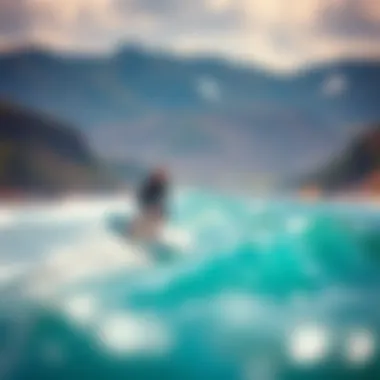
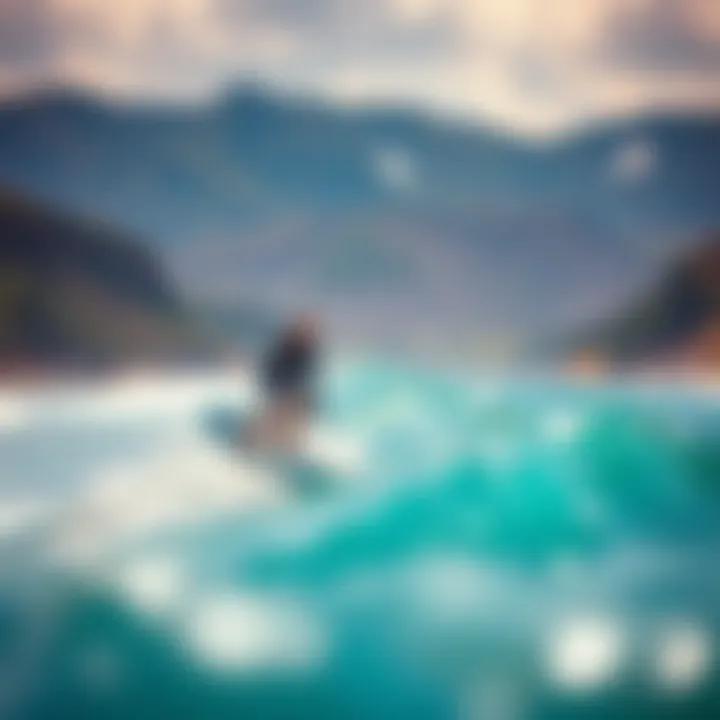
The quest for the perfect landsurfing location can be akin to searching for buried treasure. Not every flat patch will do; you need terrain that provides both variety and safety. Ideal spots are often defined by:
- Smoothness of the Surface: Look for areas with solid, even ground, free from rocks, potholes, or any other hazards. Asphalt, packed dirt, or finely crushed gravel can offer a great riding experience.
- Incline and Decline: Gently sloping hills can give you a natural boost, whereas flatlands may require more legwork. A slight downhill path allows for acceleration, making it easier to practice those tricks.
- Obstacles for Skill Array: When you get a bit more advanced, think about incorporating obstacles like ramps or barriers into your routine. Local parks or skate areas can often cater to these needs.
- Accessibility and Space: Ensure that your chosen location allows for easy access. Wider spaces are preferable for practice and exploration, as they prevent congestion and accidents, especially when you're starting out.
Finding these ideal terrains might mean exploring your neighborhood or venturing to local parks. Keen observants might even discover promising spots in less conventional places like community pathways or empty parking lots.
Environmental Considerations
While looking for suitable spots, it’s prudent to be mindful of our surroundings. Just as surfers respect the ocean, landsurfers have a duty to consider their land environment. Key points to reflect upon include:
- Preserving Natural Terrain: Avoid areas that are ecologically sensitive or protected. Riding on fragile ecosystems, like sandy dunes or wetlands, can cause irreversible damage. Respecting these places ensures sustainability for future generations of landsurfers.
- Weather Conditions: Keep an eye on the weather before you hit the road. Wet surfaces can lead to slippery rides and unfortunate tumbles. Dry, clear days are optimal, but watch out for temperature extremes that might warp equipment or impact performance.
- Community Respect: Engaging with your environment often means sharing spaces with others, be it pedestrians or park-goers. Understanding local rules and sharing the area can mitigate conflicts and promote a positive public image of landsurfing.
"Smart choices on terrain not only enhance your riding experience but also contribute to our duty of environmental stewardship."
By honing in on these aspects, landsurfing evolves beyond mere sport into a practice rooted in awareness and care for nature, ultimately enriching the experience for everyone involved.
Community and Culture
The essence of landsurfing stretches far beyond the individual thrill of riding across diverse terrains. At the heart of this activity lies a vibrant community that fosters a unique culture, one that embraces both the exhilaration of landsurfing and the camaraderie it inspires. Within this context, understanding the significance of community and culture lies pivotal for enthusiasts and newcomers alike.
Landsurfing Events and Gatherings
Landsurfing events and gatherings play a foundational role in solidifying this community. They serve as platforms where riders can come together to celebrate their passion, exchange knowledge, and hone their skills. These events often feature competitions, workshops, and social gatherings that strengthen bonds among landsurfers.
Participation in such gatherings offers several benefits:
- Skill Development: Many events include coaching sessions where experienced riders share tips and techniques, allowing newer riders to learn from the best in the field.
- Networking: Meeting fellow landsurfers can lead to friendships and collaborations. Riders often connect with others who share the same interests, creating lasting relationships that transcend the sport.
- Cultural Exchange: Events often attract diverse participants from various backgrounds, contributing to a rich tapestry of cultures and styles that influence techniques, equipment choices, and even community values.
"In the world of landsurfing, every event is more than just competition; it’s a celebration of life, passion, and shared experiences."
Specifically, gatherings like the Landsurf Festival not only showcase biking skills but also promote eco-friendly practices and community spirit.
Building a Landsurfing Community
Forming a landsurfing community is more than just sharing a hobby; it’s about embracing the principles of inclusivity and support. Building this network requires effort and intentionality. It’s essential for individuals to actively engage with each other, share resources, and promote a welcoming atmosphere for newcomers.
Key considerations for cultivating a strong landsurfing community include:
- Mentorship Programs: Veteran riders can offer guidance to novices, ensuring that newcomers feel comfortable and eventually become active participants in the sport.
- Local Clubs and Online Forums: Establish clubs or connect through platforms like Reddit to discuss local spots, equipment trade, and upcoming events. Websites such as landsurfcommunity.com and forums on facebook.com can be excellent resources for ongoing discussions.
- Inclusivity: Encourage participation from all demographics. Opening up the sport to various age groups, skill levels, and backgrounds enriches the community and enhances the overall experience.
- Environmental Initiatives: A commitment to preserving natural landscapes is crucial. Organizing clean-up events at landsurfing locations not only improves the environment but also strengthens community ties.
Creating a solid landsurfing community helps preserve the culture surrounding this sport while promoting growth, skill development, and environmental stewardship.
The Future of Landsurfing
As landsurfing continues to gain momentum, it is essential to delve into what lies ahead for this vibrant subculture of surfing. The future is shaped by emerging trends, technological advancements, and a collective ethos that prioritizes connectivity—to both the community and the environment. This exploration reveals not just the excitement of the sport but also its implications for personal development and sustainability.
Trends to Watch
The landscape of landsurfing is evolving, and several trends are emerging that enthusiasts should keep an eye on:
- Growing Popularity: More people are looking for alternatives to traditional surfing, especially those disconnected from coastal regions. Landsurfing offers an exciting option that can be enjoyed on various terrains.
- Customization in Equipment: Riders are increasingly personalizing their landsurfboards. Companies are beginning to cater to specific needs, allowing for varied board designs that can suit individual styles and preferences.
- Youth Engagement: Schools and youth organizations are incorporating landsurfing into their programs. This introduces the sport to a younger audience, ensuring that the enthusiasm for landsurfing will thrive in the coming years.
- Environmental Concerns: An increasing awareness of environmental issues is pushing landsurfers to adopt eco-friendly practices. This includes using sustainable materials in board design and promoting clean riding areas.
Integration with Technology
Technology is set to play a pivotal role in the future of landsurfing. Here’s how:
- Smart Wearables: Devices that monitor performance metrics are becoming commonplace. Riders can track their speed, distance, and even foot placement, leading to enhanced skills and safety.
- Social Media Platforms: Platforms like Instagram and TikTok provide riders a way to share their experiences and connect with others. This fosters a sense of community, uniting landsurfers across different regions.
- Virtual Reality (VR): With advancements in VR technology, aspiring landsurfers might experience training sessions in a simulated environment. This adds excitement and a layer of safety when learning new techniques.
- Online Courses and Tutorials: The development of digital learning materials is accelerating skill acquisition. Platforms like YouTube or even specific landsurfing websites are crucial resources for beginners and veterans aiming to refine their techniques.
It's clear that the future of landsurfing is bright, ripe with innovations and opportunities for growth. Those invested in this culture will find themselves at the forefront of an exhilarating evolution in sport, intertwined with personal growth and environmental stewardship.
"The horizon of landsurfing continues to expand, pushing boundaries both physically and ideologically."
In summary, the fusion of technology and community dynamics is set to enrich the landsurfing experience, opening doors for those ready to ride the wave of the future.
Comparative Analysis: Landsurfing vs. Traditional Surfing
Understanding landsurfing in relation to traditional surfing offers essential insights into its unique characteristics and evolving culture. It’s not just about comparing two sports; it’s about appreciating the blend of land and sea, adrenaline and control, that defines both worlds. Landsurfing fills a gap for those seeking the thrill of surfing while removing the constraints of ocean access. It introduces new elements, terrain, and community dynamics that traditional surfing lacks.
Technique and Style Comparison
The techniques used in landsurfing diverge significantly from those found in traditional surfing. While the basic premise of balancing on a board remains in both sports, the execution requires distinct approaches. Landsurfing often demands agility and adaptability as riders navigate uneven terrains, such as parks or natural trails. In contrast, traditional surfing focuses mainly on wave dynamics.
- Balance: In landsurfing, balance is critical, especially when negotiating bumps or sharp turns. Riders might use a wider stance compared to typical surfers.
- Turns and Carves: Landsurfers often utilize tighter turns facilitated by their surroundings, whereas surfers carve through waves utilizing fluid motion influenced by the wave energy.
- Speed Control: Landsurfers frequently rely on shifting their weight to manage speed, suited for various surfaces, like pavement or dirt. Traditional surfers must harness water currents, relying on their instincts and wave patterns to maintain speed.
The style differences are stark as well. Landsurfing can incorporate unique tricks drawn from skateboarding and snowboarding, introducing flips and spins that are typically not seen in the surfing world. This provides landsurfers with diverse stylistic options.
Cultural Differences
Culturally, landsurfing represents a broadening of the surf community, attracting enthusiasts from various backgrounds. It promotes inclusivity because it can be practiced in many places, away from the ocean. Unlike traditional surfing, which often comes with its own cultural norms—like surf etiquette and wave hierarchy—landsurfing thrives on accessibility. Riders often congregate in urban setups or skate parks, fostering a vibe of community focused on fun rather than competition.
- Event Dynamics: Landsurfing gatherings, such as urban rides or open competitions, tend to embrace a festival atmosphere. In contrast, traditional surfing competitions are marked by formal judging and more structured environments.
- Inclusiveness: The landsurfing community includes a broad spectrum of participants, from children zipping down hills to older enthusiasts showing off their skills. This mix cultivates an environment where the spirit of exploration takes precedence over strict adherence to tradition.
"Landsurfing embodies the concept of a free spirit, dashing along land instead of riding waves, yet sharing the same joys of balance and adrenaline."
As landsurfing continues its rise, the differences and similarities with traditional surfing outline a potential future where both sports cross-pollinate, enriching their respective communities. Understanding these elements allows participants to appreciate the full landscape of surf culture as it evolves.
Safety Considerations
When delving into the world of landsurfing, safety isn't just a side note but rather a cornerstone of the entire experience. Every enthusiast, whether a seasoned sailor of the waves or a newcomer, must be equipped with the knowledge of how to navigate the risks that come along with this exhilarating activity. Understanding safety measures not only protects the individual but also promotes a sustainable and responsible community.
Common Risks Associated with Landsurfing
Landsurfing, while thrilling, involves its share of risks that can mar an otherwise smooth ride. It is essential to be aware of these potential hazards:
- Terrain Hazards: Unpredictable surfaces pose a risk. Rocky paths, loose gravel, or uneven ground can lead to falls or injuries. Monitoring the surface before taking a ride is crucial.
- Weather Conditions: Wind can greatly affect control over the board. Sudden gusts can easily throw off balance, leading to crashes or injuries. It's a smart move to check the forecast before heading out.
- Inadequate Protective Gear: Riding without the proper gear can turn a minor fall into a serious injury. Helmets, knee pads, and wrist guards are not just recommendations; they are necessities.
- Collisions: Just like in any sport, there’s a risk of colliding with obstacles or other riders. Awareness of surroundings and maintaining a safe distance are key.
- Fatigue: Riding for too long without breaks can lead to decreased performance and potential accidents. Listening to one’s body is crucial for both safety and enjoyment.
Always remember, being prepared is half the battle. Safety gear and smart planning are not just accessories; they are lifesavers.
Best Practices for Safe Riding
To truly enjoy landsurfing, integrating safety into your routine is paramount. Here are some best practices to help ensure your ride is both fun and secure:
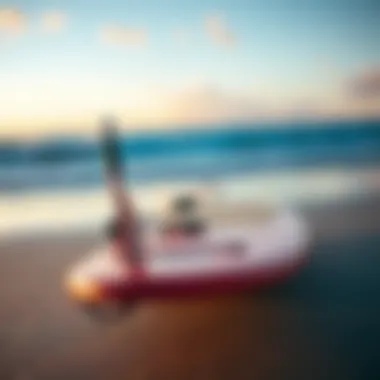
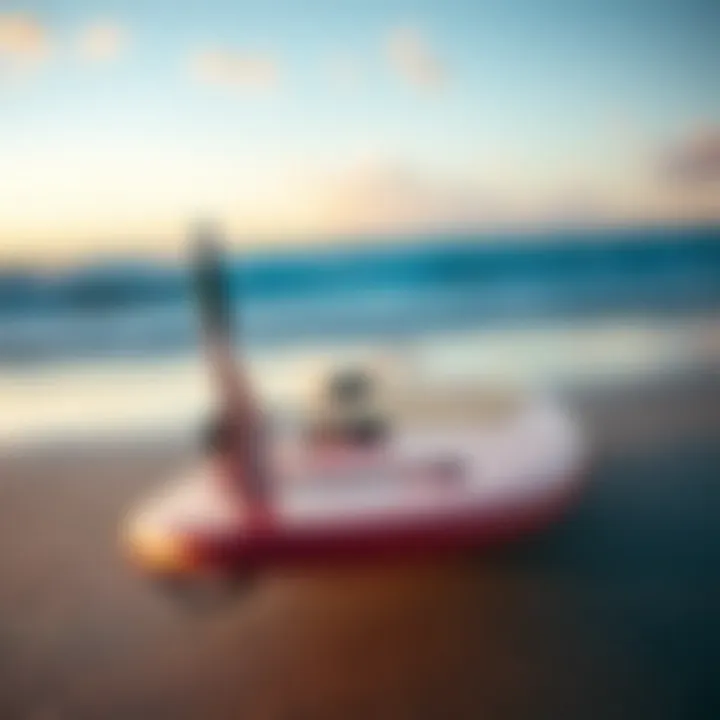
- Wear Appropriate Gear: Always wear a helmet and consider additional padding on knees and elbows. Certain surfaces may require specific protective equipment that is better suited for the terrain.
- Pre-ride Inspection: Before setting out, conduct a quick inspection of your equipment. Check the integrity of your landsurfboard, the condition of your wheels or tires, and ensure everything is in tip-top shape.
- Know Your Limits: Start with shorter trails or less complicated techniques to build up confidence and competence. Gradually increase difficulty as skills improve.
- Stay Focused: Avoid distractions, whether it’s the allure of a buzzing phone or loose conversations. Being mentally present can prevent accidents and ensure a smoother ride.
- Ride with Others: Whenever possible, landsurf with friends or in groups. Having someone else around not only adds to the fun but also enhances safety through shared vigilance.
- Take Breaks: Don’t push too hard. Taking regular breaks can help maintain energy levels and sharpness. Plus, it’s a good time to evaluate if your equipment is holding up well.
Being informed about risks and adhering to best practices defines a rider’s safety landscape in landsurfing. As landsurf culture grows, fostering safe practices helps sustain the community and welcomes newcomers successfully. Embracing these precautions enhances the enjoyment and longevity of your landsurfing adventures.
Landsurfing and Environmental Stewardship
In the context of landsurfing, one must consider how this exhilarating sport interacts with nature. Unlike its oceanic counterpart, landsurfing embraces the topography of the earth and typically occurs in diverse environments such as hills, parks, and urban settings. With this shift from surf to land, the responsibility to protect these outdoor playgrounds becomes paramount. The relationship between landsurfing and environmental stewardship invites a rich discourse on sustainable practices and community initiatives aimed at protecting our natural surroundings.
Promoting Sustainable Practices
As landsurfing grows, it’s imperative that enthusiasts adopt sustainable practices that reflect respect for the environment. This not only fosters a better relationship with nature but also ensures that future generations can enjoy the thrills of landsurfing. Here are some sustainable methods to consider:
- Eco-friendly equipment: Opt for landsurfboards made from sustainable materials like bamboo or recycled plastics. Brands are starting to emerge that focus on environmentally responsible manufacturing.
- Leave no trace: Landsurfers should practice the Leave No Trace principles by minimizing their impact on the land. This includes taking trash with them and avoiding damage to local ecosystems.
- Group riding: Organize group rides that focus on local cleanup efforts as well. By pairing the joy of riding with community service, landsurfers can create a positive impact while enhancing camaraderie.
Ultimately, the goal is not just to enjoy landsurfing but to ensure that the environments where we ride remain thriving ecosystems.
Conservation Initiatives
Numerous conservation initiatives are taking shape in the landsurfing community, highlighting its commitment to environmental stewardship. Engaging in these initiatives can make a tangible difference and foster a deeper connection between landsurfers and their surroundings. Here are a few noteworthy examples:
- Partnerships with environmental organizations: Collaborations between landsurfing groups and environmental nonprofits can facilitate park cleanups and habitat restorations. These partnerships educate participants on the local environment and its needs.
- Advocacy for sustainable park practices: Landsurfers can advocate for improved policies within local parks, ensuring they remain accessible and well-maintained without harming natural habitats.
- Educational workshops: Some groups hold workshops that teach both newcomers and seasoned riders about environmental responsibility and techniques to preserve the landscapes they cherish.
"The earth has music for those who listen." This sentiment resonates deeply with landsurfers engaging in conservation efforts. When they contribute to environmental stewardship, they ensure that the exhilarating rhythm of nature's landscapes continues untouched and available for riding.
By weaving these threads of sustainable practices and conservation initiatives into the fabric of landsurfing culture, we pave the way for a sport that remains vibrant while nurturing the very terrains that provide its thrill.
In-Depth Profiles of Influential Landsurfers
The exploration of landsurfing is incomplete without acknowledging the individuals who have shaped this exciting subculture. These influential landsurfers not only demonstrate exceptional skills on the terrain but also embody the spirit and principles of the landsurfing community. By focusing on their journeys, innovations, and contributions, one gains a clearer understanding of how landsurfing is evolving and its impact on broader surf culture.
Their stories are not just about personal achievement; they symbolize the challenges and growth of a movement that blends traditional surf values with a fresh thrill found on land.
"Landsurfing is about finding your flow, whether it's on a board or your own path in life."
Trailblazers in the Community
Trailblazers are the backbone of any community, and in landsurfing, the pioneers set the stage for what is possible on land. Not all landsurfers may achieve fame, yet their contributions often lay the foundation for future generations to build upon.
Consider figures like Jamie McFarlane, who introduced cutting-edge techniques that challenged conventional notions of balance and control on landboards. His commitment to experimenting with different terrains has inspired many to think outside the box and explore their local parks or unused spaces as potential landsurfing spots.
Among others, Sofia Tran has become a key figure through her community-building efforts. Not only does she excel in landsurfing, but she also fosters inclusivity, encouraging newcomers to join and engage. This sense of belonging is crucial in a sport that thrives on personal expression and sustainability.
The blend of innovation and community engagement displayed by these trailblazers illustrates how landsurfing extends beyond physical prowess—it's as much about promoting shared experiences.
Emerging Talent
As with any evolving sport, new talent continually emerges, bringing fresh ideas and techniques. Emerging landsurfers are pushing boundaries, finding ways to capture the essence of landsurfing in their unique styles. For instance, look at Ethan Liu, a young landsurfer whose creative approach combines dance-like movements with traditional techniques. His videos on social media showcase how combining art with athleticism can redefine expectations.
Another rising star, Lara Schmidt, emphasizes environmental awareness in her practice. She uses her platform to promote eco-friendly gear and advocate for the preservation of landscapes—tackling crucial issues within the surfing community as a whole.
These young athletes not only represent the future of landsurfing but also reveal the deepening connection between sports and social responsibility in modern culture. Their stories resonate, highlighting the importance of nurturing talent while emphasizing commitment to sustainability.
In summary, the profiles of influential landsurfers reflect a rich tapestry of experiences and philosophies that unite the community. This deeper understanding enables enthusiasts and newcomers alike to appreciate the journey and evolution of landsurfing. Whether it’s through the daring tricks of trailblazers or the innovative styles of emerging talents, the essence of landsurfing remains vibrant, passionate, and continuously evolving.
Landsurfing across Different Cultures
Understanding landsurfing is not just about the gear or the techniques; it’s also about the communities and cultures that shape and are shaped by this exhilarating sport. The act of landsurfing transcends borders, revealing how different cultures interpret and practice this activity. This global perspective adds layers of richness to the sport, hinting at its universal appeal and adaptability. Here’s a closer look at how landsurfing manifests across various cultures.
Global Perspectives on Landsurfing
From the sandy dunes of Dubai to the mountain trails in Colorado, landsurfing takes many forms. Each region boasts its own flair which directly influences the riding experience. The connections between the land and the technique applied tell stories of heritage and creativity.
- Middle East Influence: In places like the United Arab Emirates, elaborate structures such as sand dunes create a playground for landsurfers. The thrill of speeding down slopes carved by the desert sun offers a unique ride that aligns with the cultural affinity for adventure and exploration.
- North America: The landscapes of California and Oregon provide an eclectic mix of terrains, from concrete skate parks to sandy beaches, inviting people from various backgrounds to engage in landsurfing. Here, the culture leans towards innovation, with many enthusiasts constantly experimenting with new techniques and equipment adaptations, often shared through social media channels.
- Europe’s Diverse Terrain: In countries like France and Switzerland, landsurfing is a fusion of thrill-seeking and artistic expression. Riders often incorporate elements of skateboarding and snowboarding techniques, showcasing how traditions intertwine. The vibrant festivals celebrating this sport also foster local community ties and global networks.
"Landsurfing serves as a bridge between cultures, allowing people to share experiences that resonate deeply, beyond simply riding a board."
Regional Variations in Technique
As landsurfing fills the air with excitement, the techniques employed reflect the environments in which they are practiced.
- Sand Technique: In sandy locations, like beaches or dunes, surfers often utilize a wider stance and smaller boards designed for soft landings, allowing for smooth glides across the silky grains. Practices can include carving and sliding, mimicking familiar surf practices adapted for terrestrial surfaces.
- Urban Riding: In cities, landsurfers might engage in more compact, maneuver-based tactics on skate parks or streets. Here, tricks like ollies and grinds dominate, with riders using specialized boards tailored for robustness and agility.
- Mountain Trails: Conversely, those taking to rocky hill trails might focus on balance and precision, often using heavier and sturdier boards that withstand bumps. Techniques here vary, with an emphasis on terrain adaptability, incorporating jumps and downhill racing, necessitating a deeper understanding of both gravity and speed.
Exploring each of these variations not only showcases the versatility of landsurfing but also highlights how cultural and environmental factors can shape riding styles.
The joys and stories of landsurfing remind us that whether one rides on soft sands or rugged trails, this growing community thrives on diversity, creativity, and a shared passion for adventure.
Transitioning from Surfing to Landsurfing
The surf culture we know today has evolved throughout the decades, building on traditions while adapting to new environments and audiences. Transitioning from the ocean to the land through landsurfing is a significant departure that honors the spirit of surfing yet engages with fresh possibilities. This shift highlights not only the physical demands of this sport but also the mindset required for tackling uncharted territories. Embracing landsurfing can expand one’s horizons, offering unique experiences distinct from traditional surfing.
Skills Transfer and Learning Curve
When transitioning, most traditional surfers will find a degree of skill transfer that serves as a valuable foundation. Balance, momentum, and board control are pivotal elements in both sports. In landsurfing, however, you'll encounter surfaces that vary greatly, from rough pavement to smooth trails. This adds layers of complexity that can feel daunting initially.
Some may feel like a fish out of water, yet the learning curve can be quite gratifying. Here are important points to consider:
- Balance Variability: Whereas ocean waves provide a rolling platform, the ground beneath you in landsurfing can have unexpected inconsistencies. Adjusting to these changes can enhance your overall agility.
- Speed and Stopping: With landsurfing, achieving speed can initially seem easier, but knowing how to slow down or stop on diverse terrains is crucial. It’s vital to practice different braking techniques to avoid spills.
- Maneuvering Techniques: The stance may feel familiar, but adapting your movements to land requires a shift in approach. Transitioning from carving on a wave to gliding on a street means refining how you shift your weight.
As you hone your skills, learning from others in the community can be an invaluable resource. Engaging in training sessions or riding with experienced landsurfers can fast-track mastery and provide insights into techniques that may not be obvious at first.
Maintaining Surfing Skills
Though landsurfing offers its own thrills, it can be tempting to let traditional surfing skills fade into the background. However, staying connected to both activities can significantly enhance your proficiency. The ocean and land may seem different, but each venue offers insights into the other.
To maintain your surfing skills while exploring landsurfing, keep a few strategies in mind:
- Regular Ocean Sessions: Ensure that you still get your fill of the waves. This keeps your instincts sharp and maintains the muscle memory developed through years of surfing.
- Cross-training Routines: Consider incorporating exercises that enhance both sets of skills. Things like core workouts, balance training, and even yoga can help in adapting to the shifting dynamics of both surfing and landsurfing.
- Community Engagement: Immerse yourself in both surf and landsurfing communities. This interaction allows you to share insights and absorb new perspectives, enriching your experience and fostering a deeper connection to both worlds.
Ultimately, maintaining an active engagement in both domains fosters a robust skill set while keeping the enjoyment of the sport at the forefront. Transitioning from surfing to landsurfing may appear to be a drastic transformation, but it often results in a remarkable enhancement of one's surfing journey overall.
The Role of Social Media in Landsurfing
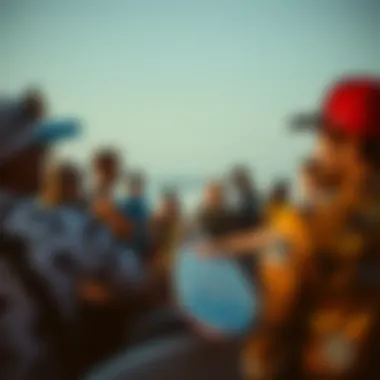
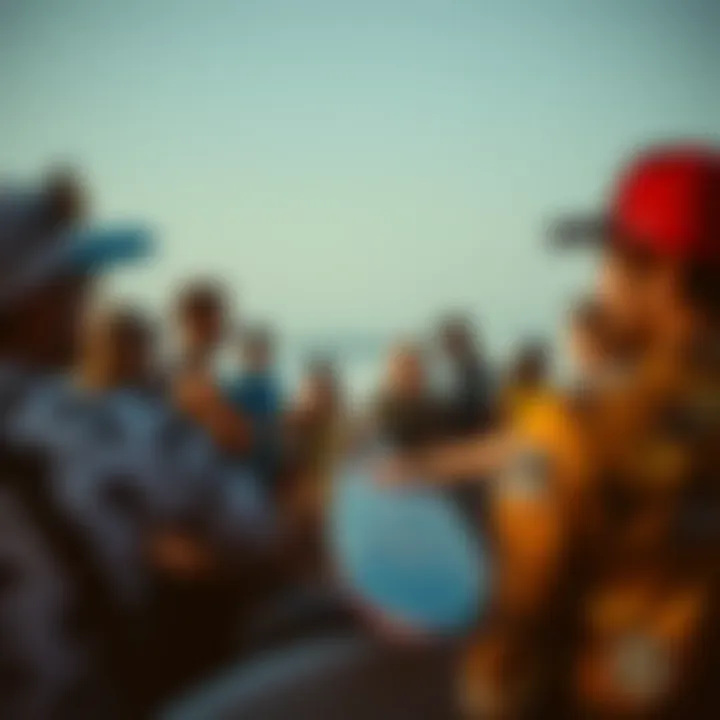
Social media plays a crucial part in the rise and spread of landsurfing culture. With the ability to share experiences, techniques, and locations, platforms like Instagram, TikTok, and YouTube have allowed from newcomers to seasoned pros to showcase their skills and passion. This digital presence not only connects individuals but also helps cultivate a vibrant community around this exhilarating sport.
Influencers and Content Creation
In the world of landsurfing, influencers have taken the spotlight, leveraging their platforms to promote the sport and present it in a captivating manner. These individuals often possess a blend of charisma and skills that draws attention to their posts, whether it's through thrilling action shots or detailed tutorials. Here are a few elements to consider regarding influencers in landsurfing:
- Skill Recognition: Influencers often achieve recognition by demonstrating high-level techniques, which encourages others to aspire to similar achievements.
- Localized Content: Many influencers share insights about specific terrains or local conditions, providing valuable information for riders looking to expand their horizons.
- Sponsorships: Partnerships with brands boost visibility; these collaborations can amplify the influence, allowing for better equipment access and promotion of the sport.
Additionally, the creativity behind content creation is one of the driving forces in attracting new people to landsurfing. Engaging videos, eye-catching imagery, and clever editing can transform ordinary experiences into extraordinary showcases, inspiring people to take to the land in search of their own adventures.
Building a Digital Community
Creating a sense of community is essential within the landsurfing realm, and social media serves as an ideal vehicle for fostering these connections. Many enthusiasts leverage platforms to share stories, exchange tips, and perhaps most importantly, to support one another. Here’s how a digital community thrives:
- Interactive Engagement: Through comments and direct messages, riders can connect instantly, creating dialogue that fosters camaraderie.
- Event Coordination: Online platforms often host events or meet-ups, where local landsurfers can unite for competitions or group rides, enhancing the spirit of the sport.
- Shared Resources: Access to blogs, forums, and videos provide invaluable learning material, which cultivates an environment where beginners can thrive and advance quickly.
"In a world increasingly connected by technology, social media has woven a safety net for the landsurfing community, enabling knowledge and passion to travel like a swift wave."
In essence, the role of social media in landsurfing extends beyond mere entertainment; it creates a supportive environment where enthusiasts can grow, learn, and celebrate their passion. As more people engage with these digital platforms, the culture of landsurfing will likely continue to flourish, evolving with fresh perspectives and ideas.
Resources for Aspiring Landsurfers
As landsurfing continues to carve its niche within the broader surfing culture, the resources available to newcomers and enthusiasts are more important than ever. These resources not only equip aspiring landsurfers with the practical knowledge they need but also provide a pathway to engage with a vibrant community. Whether you’re looking for tutorials, gear insights, or community events, having access to the right information can drastically enhance your experience onland.
Guides and Tutorials
In the journey of mastering landsurfing, guides and tutorials are like treasure maps, pointing you toward essential skills and techniques. Online platforms offer a diverse assortment of instructional content, from beginner tips to advanced tricks. Here’s what to look for:
- Visual content: Videos can be particularly helpful. They allow you to see techniques in action, making it easier to replicate. Websites like YouTube provide a plethora of channels dedicated to landsurfing, where experienced riders share their wisdom, demonstrating maneuvering techniques step-by-step.
- Written guides: Blogs and articles provide deep dives into specific aspects. Search for articles that detail the nuances of balance, turning techniques, and appropriate body positioning. Look out for resources that also touch on the mental aspects of riding, as understanding your psyche on the board is crucial for mastering this sport.
- Training camps: Engaging in workshops can further solidify one's skills. These immersive experiences typically offer instruction from experienced riders, allowing for hands-on feedback.
"Action is the foundational key to all success."
– Pablo Picasso
Equipment Reviews and Recommendations
Equipping yourself properly is fundamental to enjoying and excelling in landsurfing. The right board and gear can make all the difference between a smooth ride and a bumpy experience. Here’s how to navigate the overwhelming landscape of options:
- Understand your needs: There’s a variety of landsurfboards tailored for different terrains and skill levels. Research what suits you best. Options range from light boards for speed to sturdier models for tricks.
- Read reviews: Platforms like Reddit or specialized forums can provide firsthand experiences from landsurfers regarding specific equipment. Pay close attention to durability, performance, and user comfort.
- Join community chats: Engaging in discussions on social media platforms or forums can unveil recommendations that come straight from seasoned surfers. Places like Facebook groups dedicated to landsurfing often have active members sharing insights and gear reviews.
By leveraging these resources, aspiring landsurfers can confidently step into this exciting blend of culture and sport. Finding quality guides, equipment, and connecting with the community not only enhances the learning experience but also fosters a deeper love for the landsurfing journey.
Contests and Competitions in Landsurfing
The world of landsurfing is not merely confined to the joy of riding. It extends into a vibrant tapestry of contests and competitions that serve a multitude of purposes in nurturing and promoting this thrilling activity. These events are particularly important as they bring together practitioners of all skill levels, fostering community and sharing valuable techniques. Whether you're an experienced rider or just starting, participating in competitions can be an exhilarating way to test your limits, learn from others, and gain recognition in the landsurfing circle.
Major Events Overview
Annual competitions play a significant role in establishing landsurfing as a recognized sport. Some well-known events include the Landsurfing National Championships and the Global Landsurf Open. These gatherings are more than mere contests; they transform into festivals of sorts, celebrating the culture and camaraderie inherent in landsurfing. Riders travel from all corners of the globe, showcasing various styles that reflect their local terrains and techniques.
When we pinpoint a few notable contests, the Landsurfing Pros' Showcase often heads the list. This high-stakes event emphasizes not just the thrilling displays of skill but also the athlete's creativity and innovation. Judges are keenly interested in how competitors adapt their land surfing moves to different types of surfaces and challenges, reflecting their adaptability and skill.
Additionally, many competitions have been notable for their inclusive approach, offering categories for different age groups and skill levels, from novice divisions to advanced riders. Such segmentation encourages broader participation and makes it easier for newer entrants to gain experience in a welcoming environment.
"Competitions are where we begin to see the heart and spirit of landsurfing. As much as it is about winning, it's also about the friends we make and the stories we share."
— An experienced landsurfer
Preparing for a Landsurfing Contest
Preparation for a landsurfing contest requires more than merely hoping onto a board and riding off into the sunset. Here’s a list of essential things to consider when gearing up for competition:
- Skill Level Assessment: Know your strengths and weaknesses. Reflecting on previous rides helps inform your strategy moving forward.
- Practice Sessions: Schedule disciplined practice sessions, focusing on mastering techniques that suit the competition format. Practice makes perfect.
- Equipment Check: Ensure your landsurfboard and safety gear are competition-ready. A thorough inspection can save you from unexpected equipment failures.
- Familiarization with Terrain: Knowledge of the competition location is crucial. Understanding the terrain can offer advantages, whether it's downhill slopes or rugged surfaces.
- Mental Preparation: Contests can be nerve-wracking. Mental resilience, like visualization techniques and breathing exercises, can help maintain focus.
- Nutrition and Hydration: Map out a nutrition plan that supports optimal performance. Staying hydrated is vital, particularly under grueling conditions.
Engaging in contests doesn’t just refine skills; it solidifies your bond with the landsurfing community. As you prepare, remember that the ride transcends the competition, building a foundation for lasting relationships with fellow enthusiasts.
The Impact of Landsurfing on Personal Growth
Landsurfing, as a dynamic variant of traditional surfing, brings not just thrill and adventure but also significant value in terms of personal development. This unique practice allows participants to cultivate skills and attributes that go beyond the physical aspect of the sport. Engaging in landsurfing presents opportunities for fostering resilience, building confidence, and enhancing a deeper connection with nature.
Developing Resilience and Confidence
At the core of landsurfing is the necessity for resilience. Riders often face the unpredictability of diverse terrains and changing weather conditions. Whether it’s navigating through rough patches or maintaining balance on an uneven surface, the mental and physical challenges encourage individuals to push their boundaries.
Being resilient in landsurfing involves more than merely physical endurance. It also encapsulates the mental toughness required to persist, especially during the learning phases. Each fall teaches surfers to get back up and try again, molding not just a better athlete but a more tenacious individual. The repeated triumph over small challenges builds confidence over time and empowers surfers to tackle bigger hurdles, both on and off the board.
This newfound confidence can penetrate various aspects of life, encouraging practitioners to take on challenges with a positive outlook. For many, the confidence cultivated through landsurfing spills over into their professional lives or personal relationships, giving them the ability to handle stress and unexpected situations with grace.
Enhancing Connection with Nature
Landsurfing fundamentally draws its essence from the great outdoors. Unlike gym workouts confined within four walls, landsurfing invites participants to revel in nature’s beauty. One can often be found carving along coastal paths, descending grassy hills, or traversing sandy dunes. This intimacy with the natural environment fosters a connection that’s both grounding and exhilarating.
When landsurfers engage with their surroundings, they become more aware of their ecosystems—learning to recognize terrain variations, understand wind direction, or anticipate the impact of different surfaces under their feet. These experiences not only enhance a surfer’s skill but also instill a sense of responsibility towards preserving those very landscapes that bring joy and adventure.
Moreover, the serene moments spent outdoors allow for reflection and mindfulness. Many landsurfers find peace in the rhythm of rolling waves and the scent of fresh air, encouraging a holistic approach to well-being. This connection with nature is profound; it is a reminder of one's place within the environment and can lead to a sustained commitment to environmental stewardship.
"Landsurfing bridges the gap between sport and appreciation for nature, allowing individuals to develop not only as athletes but as conscientious citizens of the earth."
Culmination
In summary, the impact of landsurfing on personal growth is multifaceted. The practice cultivates resilience and confidence while simultaneously nurturing a connection with the natural world. As more individuals embrace landsurfing, they find themselves not just in pursuit of thrilling rides but also in a journey of self-discovery and personal development. This growth, intertwined with nature, shapes a holistic lifestyle that enriches mind, body, and spirit.
Final Thoughts on Landsurfing
Landsurfing is more than just a thrilling activity; it serves as a poignant bridge between the traditional surf culture and land-based adventures. In a world with ever-changing landscapes, this new dimension brings fresh opportunities for surfers seeking to extend their passion beyond coastal waves. Understanding landsurfing can open up a treasure trove of experiences, allowing for an appreciation of nature’s vast terrains in ways that traditional surfing may not offer. It encourages explorers to think creatively about how to interact with the earth beneath their feet, bringing a unique perspective to the surfer’s mindset.
Summary of Key Points
- Intersection of Cultures: Landsurfing embodies a fusion where surfing, skateboarding, and outdoor exploration meet, creating a vibrant culture that attracts enthusiasts from various backgrounds.
- Environmental Connection: The practice emphasizes a profound bond with nature. Each run—be it through urban parks or rugged trails—encourages riders to engage with their surrounding environment, heightening their environmental consciousness.
- Technological Innovation: As landsurfing continues to grow, innovative equipment designed for specific terrains evolves. This adaptation mirrors the wider surf culture, where gear and technique development are crucial for progression.
- Community Spirit: The landsurfing community thrives on camaraderie. From local meetups to national contests, these gatherings foster relationships among riders, creating support systems that elevate everyone’s experience.
- Endless Potential: With adaptability at its core, landsurfing provides an avenue for personal growth. Enthusiasts develop resilience, confidence, and an understanding of terrain that can translate into various aspects of life.
Landsurfing’s dynamism reflects today's evolving outdoor culture, illustrating that the pursuit of adventure doesn’t have to be confined to ocean waves alone.
Looking Ahead
As we look to the horizon, several trends underline the bright future of landsurfing. Firstly, the growing integration of technology stands to revolutionize landsurfing. Developments in gear, such as smartboards equipped with sensors, can analyze performance and enhance skills. This wave of innovation is set to attract tech-savvy youth eager to improve their riding.
Additionally, the community aspect is expected to flourish through social media platforms. Riders sharing their experiences, tricks, and locations on platforms like Instagram and TikTok fosters a global network. This connects enthusiasts far beyond their physical environments, breaking down barriers and creating a united front for landsurfing.
Moreover, as environmental concerns rise, the landsurfing community has the chance to lead by example, championing sustainable practices that respect natural areas. By advocating for conservation during events or through social media initiatives, landsurfers can play a part in preserving the landscapes they cherish.
Overall, the future paints an encouraging picture for landsurfing. The balance between the thrill of the ride and the understanding of our environment has the potential to inspire a new generation of riders committed to not just the sport but the planet.



